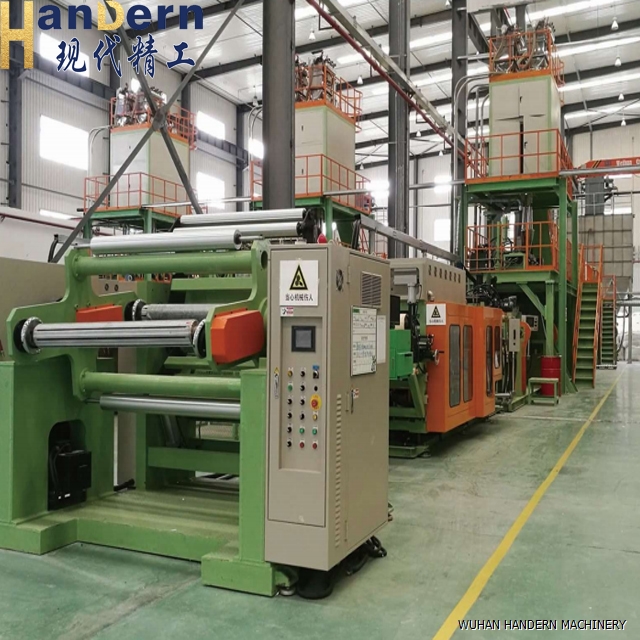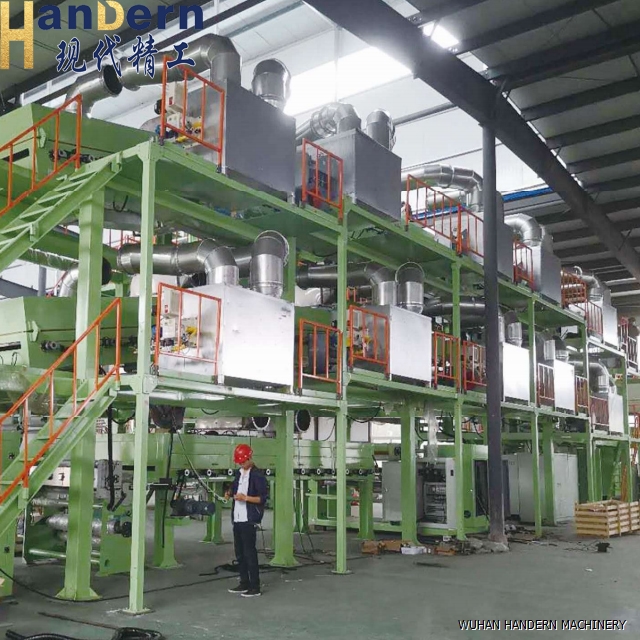What is the difference between blown film and cast film in the stone paper production line
DATE:2024/9/11 14:29:57 / READ: / SOURCE:This station
In the production process of stone paper production line, blown film and cast film are the two most commonly used processes. Their working principles have certain differences, and the finished products produced by these two processes also have significant differences in application fields and product characteristics. Today, the editor will give you a detailed introduction and comparison of these two production processes.
 1. Working principle
1. Working principle
The stone paper blown film production line adopts blow molding technology, which melts and extrudes the stone paper raw materials (mainly calcium carbonate and polyethylene), and forms a thin film through bubble expansion. During this process, molten plastic forms bubbles inside the mold, which are then cooled and stretched to form a thin film of the desired thickness and width. This device can quickly and continuously produce thin films with high production efficiency.
The stone paper extrusion production line uses extrusion molding technology to flatten and stretch molten resin materials (such as polyethylene, polypropylene, etc.) through extrusion rollers, ultimately forming a thin film. This method uses gravity to flow molten material onto a cooling roller, forming a uniform thin film. Casting machines are generally used to produce films with high transparency and glossiness, suitable for a wider range of materials.
 2. Material usage
2. Material usage
The stone paper blown film production line mainly uses stone paper as raw material. This material is mainly composed of calcium carbonate, which is environmentally friendly and recyclable, suitable for producing biodegradable packaging materials. In addition, due to its unique composition, this stone paper has high strength and water resistance, making it particularly suitable for applications that require waterproofing or load-bearing.
The stone paper casting production line can handle a variety of plastic materials, including ordinary polyethylene, polypropylene, polyester, etc., with a wider range of applications. The tape casting machine can achieve the composite and lamination of different types of plastics, meeting various special needs, such as food packaging, industrial films, etc.
3. Product Features
The products produced by the stone paper blown film production line have good waterproof, UV resistant, and tear resistant capabilities. The stone paper produced by this process is suitable for heavy packaging and outdoor advertising materials. In addition, the surface of stone paper is very smooth, suitable for printing and coating processing.
The finished products produced by the stone paper casting production line usually have high transparency and good gloss, so they are widely used in food packaging, gift packaging, and other applications that require a beautiful appearance. The stone paper produced by the casting process has good thickness uniformity and is suitable for high demand packaging fields.
 4. Production efficiency and cost
4. Production efficiency and cost
In terms of production efficiency, stone paper blown film machines can usually achieve continuous and high-speed production, suitable for large-scale production; The production speed of the tape casting machine is relatively slow, which is suitable for small and medium-sized production needs. In terms of overall cost, the raw material cost of stone paper is relatively high, but due to its environmental protection and reuse characteristics, long-term use can reduce environmental governance costs and enhance product competitiveness.

The stone paper blown film production line adopts blow molding technology, which melts and extrudes the stone paper raw materials (mainly calcium carbonate and polyethylene), and forms a thin film through bubble expansion. During this process, molten plastic forms bubbles inside the mold, which are then cooled and stretched to form a thin film of the desired thickness and width. This device can quickly and continuously produce thin films with high production efficiency.
The stone paper extrusion production line uses extrusion molding technology to flatten and stretch molten resin materials (such as polyethylene, polypropylene, etc.) through extrusion rollers, ultimately forming a thin film. This method uses gravity to flow molten material onto a cooling roller, forming a uniform thin film. Casting machines are generally used to produce films with high transparency and glossiness, suitable for a wider range of materials.

The stone paper blown film production line mainly uses stone paper as raw material. This material is mainly composed of calcium carbonate, which is environmentally friendly and recyclable, suitable for producing biodegradable packaging materials. In addition, due to its unique composition, this stone paper has high strength and water resistance, making it particularly suitable for applications that require waterproofing or load-bearing.
The stone paper casting production line can handle a variety of plastic materials, including ordinary polyethylene, polypropylene, polyester, etc., with a wider range of applications. The tape casting machine can achieve the composite and lamination of different types of plastics, meeting various special needs, such as food packaging, industrial films, etc.
3. Product Features
The products produced by the stone paper blown film production line have good waterproof, UV resistant, and tear resistant capabilities. The stone paper produced by this process is suitable for heavy packaging and outdoor advertising materials. In addition, the surface of stone paper is very smooth, suitable for printing and coating processing.
The finished products produced by the stone paper casting production line usually have high transparency and good gloss, so they are widely used in food packaging, gift packaging, and other applications that require a beautiful appearance. The stone paper produced by the casting process has good thickness uniformity and is suitable for high demand packaging fields.

In terms of production efficiency, stone paper blown film machines can usually achieve continuous and high-speed production, suitable for large-scale production; The production speed of the tape casting machine is relatively slow, which is suitable for small and medium-sized production needs. In terms of overall cost, the raw material cost of stone paper is relatively high, but due to its environmental protection and reuse characteristics, long-term use can reduce environmental governance costs and enhance product competitiveness.
Author:admin




